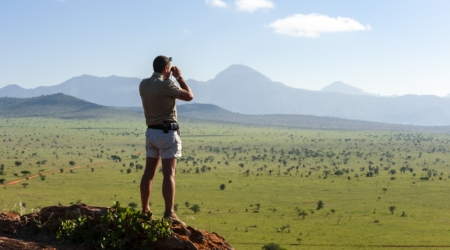The Silverback Mountain gorilla is also called the alpha male gorilla or dominant silverback gorilla is the heart and soul of every mountain gorilla family. Named for the distinctive silver patch of hair that develops on the gorilla back as they mature, typically around the age of 12, these males are the oldest and most dominant members of their groups. This grizzled fur marks their age and signals their status within the gorilla group, signifying a blend of strength, experience, and wisdom.
Silverbacks are large, formidable creatures, often weighing between 300 to 400 pounds and standing up to 6 feet tall when on two legs. Their imposing presence matches their immense physical strength, yet their role extends far beyond sheer power within their gorilla family. They are the alpha males, the ultimate decision-makers responsible for ensuring the group’s survival.
Becoming a silverback isn’t merely about physical prowess; it’s about demonstrating the capability to lead. Young male gorillas, known as blackbacks, spend years observing and learning from the group’s current silverback. This training is crucial as it prepares them to lead their own family one day or inherit leadership within the existing group.
The silverback’s presence symbolises stability for the family, providing a sense of order and security that allows the troop to thrive. His daily decisions—where to forage, when to rest, and how to respond to threats—revolve around safeguarding the well-being of each member. In a world teeming with dangers, from predators to human encroachment, the silverback stands as the family’s guardian, an irreplaceable leader who upholds the delicate balance of their ecosystem.
Leader and Protector
The silverback’s role as the leader and protector of the gorilla family is multifaceted and central to the troop’s survival. As the alpha, he is responsible for the overall well-being and coordination of the group. His leadership is not just about commanding respect; it’s a daily exercise ensuring the troop’s safety, health, and cohesion.
One of the silverback’s primary roles is deciding the group’s daily movements. Food sources can be scarce and seasonal. With his extensive knowledge of the terrain and changing seasons, the silverback guides the family to the best feeding areas. He leads the troop through the forest, setting the pace and direction and ensuring no member is left behind. This constant vigilance in choosing safe paths and quality feeding grounds keeps the group nourished and safe.
Protection is where the silverback’s power truly shines. The silverback springs into action when faced with threats from predators like leopards or even encounters with rival gorilla groups. His sheer size and strength make him a formidable opponent, capable of defending the family with displays of chest-beating, roaring, and, if necessary, physical combat. These displays intimidate potential threats and tell the group they are under his watch. In moments of danger, the family members instinctively gather around him, seeking the security of his presence.
However, his protective instincts aren’t limited to external threats. The silverback maintains order and harmony within the group, stepping in to diffuse conflicts between family members. His leadership helps regulate social tensions, fostering an environment where females and young gorillas can focus on nurturing relationships and learning essential survival skills. By keeping internal strife to a minimum, he ensures that the family unit remains bonded and functional, which is critical for their collective survival.
Guardian of Harmony: The Silverback’s Role in Family Dynamics
Beyond his duties as the group’s leader and protector, the silverback also serves as the guardian of harmony within the family. Social dynamics can become complex in a troop, including several adult females, young ones, and subadult males. The silverback plays a pivotal role in managing these relationships, ensuring peace and stability within the group.
In mountain gorilla families, conflicts are natural and can arise over food, space, or social interactions. When tensions flare, the silverback mediates, combining vocalisations, body language, and physical presence to restore order. His mere presence often serves as a deterrent to prolonged disputes. When more intervention is necessary, he may physically place himself between quarrelling members or use gestures, such as chest-beating or grunting, to signal that it’s time to calm down. His authority is rarely challenged, and his actions help establish the social norms that all troop members learn to follow.
The silverback also plays a central role in the group’s breeding dynamics. Typically, he has exclusive mating rights with the adult females in the family, helping to ensure that his genetic line is carried forward. However, this role extends beyond mere reproduction. He maintains close bonds with the females and provides a cooperative environment where mothers can rear their young with his support. His presence reassures the mothers, who know he will protect their offspring from external dangers and internal conflicts. This creates a stable family unit in which young gorillas can thrive.
Interestingly, the silverback’s influence on family dynamics is not just about enforcing order. He also nurtures social bonds through grooming, play, and physical closeness, especially with the group’s younger members. This gentle side of the silverback often goes unnoticed, but it is crucial for the troop’s social health. Through these actions, he models the behaviours younger gorillas adopt as they grow, passing down the social fabric that defines mountain gorilla families.
Nurturer and Teacher: The Silverback’s Bond with Young Gorillas
While the silverback is often seen as the imposing leader of the group, he also takes on a nurturing role, especially with the young gorillas in the family. This part of his responsibility is vital for the continuity of the troop, as it directly influences the upbringing of the next generation. The silverback’s interactions with the young go far beyond mere protection; he is their teacher, mentor, and sometimes even a playmate.
Young gorillas observe the silverback’s behaviour, learning essential survival skills. Through his daily routines, the silverback demonstrates how to forage for food, identify edible plants, and navigate the dense forest. His actions teach the young how to build nests for sleeping and how to interact with other members of the family. These lessons are not formally trained but are acquired through imitation and observation. The silverback’s patience and tolerance toward the younger members allow them to explore and practice these skills safely under his watchful eye.
In addition to teaching, the silverback plays with the young gorillas. Playtime is crucial for the development of motor skills and social bonds. While it might seem surprising to see such a large and powerful creature playing gently with the young, these interactions help to foster trust and strengthen the group’s social fabric. The silverback often lies on his back, allowing the young to climb over him or initiate gentle wrestling games. This nurturing behaviour helps the young gorillas develop physically and emotionally, giving them the confidence to grow into capable troop members.
The silverback’s bond with the young also extends to protection. When threats arise, such as potential predators or encounters with rival gorilla groups, the silverback instinctively places himself between the danger and the young. This act of shielding not only ensures the physical safety of the juveniles but also instils in them a sense of security. The young gorillas learn that they can rely on the silverback, which is crucial for their psychological development and helps maintain a cohesive group dynamic.
Therefore, the silverback’s nurturing role is a blend of protector, teacher, and affectionate caregiver. By embodying these roles, he prepares the young for adulthood and ensures that the knowledge and values of the troop are passed down, securing the family’s future.
Dietary Leadership: Foraging and Feeding Guidance by the Silverback
The silverback’s expertise in foraging is crucial for the group’s survival because food sources can be scattered and seasonal. His ability to locate and identify nutritious plants is significant in maintaining the family’s health. With his vast experience and knowledge of the terrain, the silverback leads the group to the best feeding sites, ensuring that they have access to a balanced diet throughout the year.
Mountain gorillas are herbivores with a diet mainly consisting of leaves, stems, shoots, and fruits. The Silverback’s dietary knowledge comes into play when selecting food that meets the nutritional needs of all family members, including pregnant females, nursing mothers, and growing juveniles. His experience allows him to recognise which plants are in season, which are safe to eat, and which forest areas will have the best food supply at different times of the year. This guidance is vital for the group, as foraging mistakes can lead to malnutrition or illness.
The silverback’s leadership during foraging is not limited to finding food. He also manages the group’s feeding behaviour, setting the pace for how long they spend in each area and ensuring that resources are shared. While feeding, he often positions himself in a way that allows him to keep an eye on the surroundings, ensuring that the family remains safe from potential threats while they eat. This dual role of provider and protector makes the silverback indispensable to the troop’s daily routine.
Young gorillas, in particular, benefit from observing the silverback during foraging. They watch as he selects and consumes different types of vegetation, learning which plants are edible and how to harvest them effectively. This hands-on education is crucial for their development as they gradually gain the skills needed to forage independently. The Silverback’s patient guidance ensures that the young gorillas acquire a diverse diet essential for their growth and overall health.
Through his role in foraging, the silverback sustains the group’s immediate dietary needs and imparts critical survival knowledge to the next generation. His choices in guiding the family to various feeding grounds reflect an intricate understanding of the forest ecosystem, highlighting the silverback’s role as both a wise leader and an essential teacher within the family structure.
Communication and Social Structure: How Silverbacks Maintain Order
The social structure of a gorilla family is intricate, and maintaining harmony within the group relies heavily on the silverback’s ability to communicate and enforce order. The Silverback is not only a physical leader but also the social glue that holds the family together, using a complex system of vocalisations, body language, and gestures to convey his intentions, maintain group cohesion, and establish boundaries.
Communication among mountain gorillas involves a diverse range of sounds and actions. The silverback employs deep grunts, roars, and barks to convey different messages. For example, soft grunts often indicate contentment or reassurance to the family members, while louder vocalisations can signal alarm, warning the group of potential danger. Chest-beating is one of the most iconic forms of communication displayed by the Silverback, demonstrating strength and dominance. This display, which involves rapid thumping on the chest, can intimidate rivals, assert control, or diffuse conflicts without physical confrontation.
Body language also plays a crucial role in the Silverback’s interactions. A silverback may make eye contact, display his teeth, or use specific postures to express dominance, approval, or displeasure. These visual cues are well understood within the group and help regulate social behaviour. For instance, when the silverback adopts a relaxed posture, the other members feel at ease to engage in activities like grooming or playing. Conversely, a tense stance signals the need for caution, prompting the family to stay alert and gather around him.
By consistently communicating through these vocal and physical signals, the silverback maintains a social hierarchy within the group. He sets the rules for interactions, asserting dominance over younger males (blackbacks) and regulating access to the females in the family. This structure ensures the group functions smoothly, reducing internal conflicts and promoting cooperative behaviour.
The silverback’s role in social order also extends to the group’s younger members. Juveniles often test boundaries as they learn about social norms, and the silverback’s job is to guide them. He might use a firm growl or a gentle nudge to correct behaviour, teaching the young gorillas what is acceptable within the family dynamics. Through this process, the Silverback instils a sense of discipline and respect among the group members, fostering a stable environment where each individual knows their place.
In this way, the silverback acts as the social architect of the family, not only leading them in their daily activities but shaping the complex social interactions that are vital for the group’s cohesion. His ability to communicate effectively ensures that the family moves as a united and functional unit, able to respond to internal and external challenges.



















